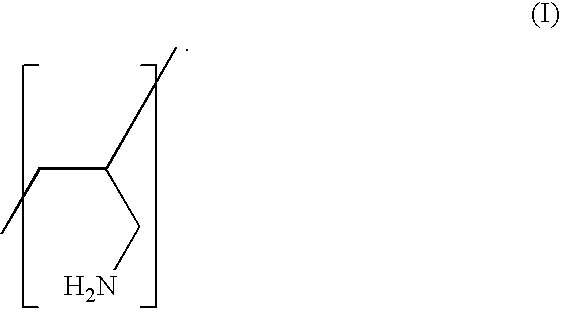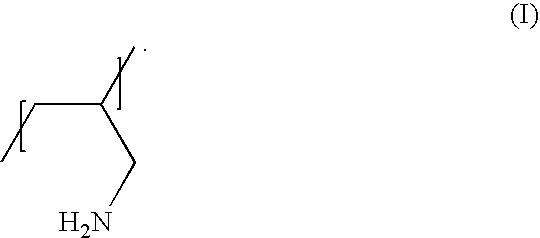Low Salt Forms of Polyallylamine
a polyallylamine and low salt technology, applied in the field of low salt forms of polyallylamine, can solve the problems of low blood ph or “acidosis" in most patients with renal failure, and achieve the effects of reducing phosphate serum levels, increasing the number of unprotonated, and reducing the number of anions
- Summary
- Abstract
- Description
- Claims
- Application Information
AI Technical Summary
Benefits of technology
Problems solved by technology
Method used
Image
Examples
example 1
Preparation of Low Chloride Sevelamer Hydrochloride (Polyallylamine Homopolymer)
[0021]Sevelamer HCl of various chloride levels (˜1%, ˜5%, ˜9% by weight) was prepared from commercial bulk Sevelamer (˜18% chloride by weight) manufactured by Dow Chemicals (Midland, Mich.). The bulk Sevelamer was slurried in water, and further neutralized with 50% aqueous sodium hydroxide (NaOH) solution. Varying amounts of NaOH were added to achieve the desired reduction in the level of chloride by weight of the polymer. For example, 0.5 equivalents of NaOH added with respect to the total chloride in Renagel (˜18%), yields approximately 50% reduction in chloride resulting in Sevelamer having about 9% chloride by weight of the polymer, 0.75 equivalents of NaOH yields approximately a 75% reduction in chloride resulting in Sevelamer having about 5% chloride by weight, and 0.95 equivalents or higher resulted in Sevelamer having about 1% chloride by weight.
[0022]Neutralized Sevelamer was filtered and resusp...
example 2
Stability Studies with Low Chloride Sevelamer HCl
[0024]The low chloride Sevelamer Hydrochloride polymers (a polyallylamine homopolymer) described in Example 1 having approximately 9%, 5%, and 1% chloride by weight of the polymer respectively, were tested for stability in accordance with the guidelines of the International Conference on Harmonization (ICH). The accelerated stability tests included placing each of the respective low chloride polymer samples, in an oven at 40 C with 75% relative humidity for 1, 2, 3 and 6 months. At each time point, a portion of each respective polymer sample was removed and analyzed using two assays, the phosphate binding assay and the soluble oligomers assay. Both assays are demonstrated as stability indicating assays for polyallylamine polymers.
[0025]The phosphate binding assay determines the phosphate binding capacity of Sevelamer Hydrochloride, which is an indicator of its therapeutic effectiveness. The assay is performed by mixing the Sevelamer H...
PUM
| Property | Measurement | Unit |
|---|---|---|
| weight | aaaaa | aaaaa |
| crosslinking | aaaaa | aaaaa |
| structure | aaaaa | aaaaa |
Abstract
Description
Claims
Application Information
 Login to View More
Login to View More - R&D
- Intellectual Property
- Life Sciences
- Materials
- Tech Scout
- Unparalleled Data Quality
- Higher Quality Content
- 60% Fewer Hallucinations
Browse by: Latest US Patents, China's latest patents, Technical Efficacy Thesaurus, Application Domain, Technology Topic, Popular Technical Reports.
© 2025 PatSnap. All rights reserved.Legal|Privacy policy|Modern Slavery Act Transparency Statement|Sitemap|About US| Contact US: help@patsnap.com



